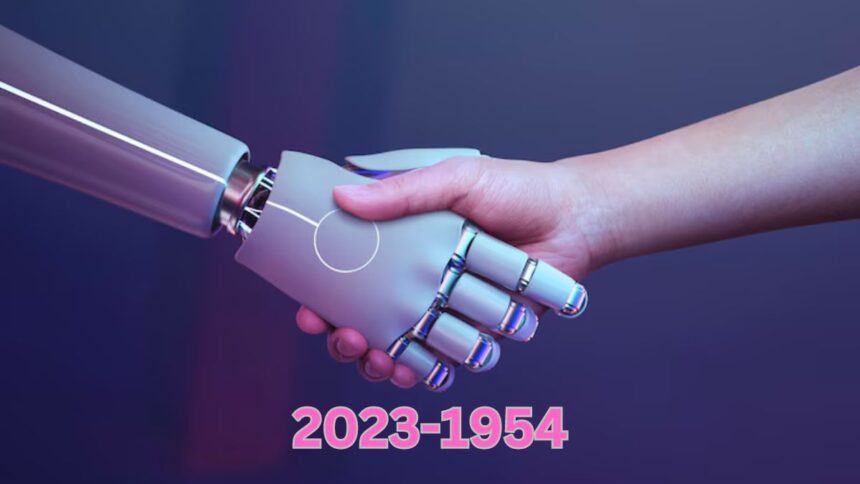The year 2023 stands as a monumental milestone in technological advancements, marking nearly seven decades of rapid innovation since 1954. The world we live in today is unrecognizable compared to that of 1954. From communication to healthcare, and from transportation to entertainment, the journey from 1954 to 2023 has been a breathtaking transformation. In this article, we will dive deep into how technological developments over the past 69 years have redefined everyday life and the major industries that have been most affected.
The World in 1954
1954 was a simpler time. Television was still in its infancy, computers were rare and enormous, and transportation mainly relied on steam and gasoline. People communicated through landlines, letters, and radios. Life revolved around local communities, and the idea of globalization was still far from being a reality.
The Advent of Computers
One of the most significant changes from 1954 to 2023 is the rise of computers. In 1954, computers were large, expensive, and only used by governments and research institutions. Fast forward to 2023, and nearly everyone has access to computers, whether in the form of smartphones, laptops, or tablets. Computers have evolved from room-sized machines to personal devices that fit in the palm of our hands, driving unprecedented connectivity and access to information.
The Rise of the Internet
Perhaps the most transformative technology of all has been the internet. The concept of a connected world did not exist in 1954. By 2023, the internet has become the backbone of global communication, commerce, and entertainment. The internet revolutionized how we work, learn, shop, and even socialize. Online platforms have turned the world into a global village, allowing instant communication regardless of geographic boundaries.
Communication Transformation
In 1954, communicating with someone in another country involved writing letters or making expensive long-distance phone calls. Today, with smartphones and the internet, communication is instantaneous and often free. From emails to video calls, social media to instant messaging, technology has bridged gaps and brought people closer than ever before.
Healthcare Revolution
Healthcare has also undergone tremendous change. In 1954, many diseases that are easily treatable today were life-threatening. Modern technology has improved diagnostics, treatments, and patient care. 2023 has seen the rise of telemedicine, robotic surgeries, and AI-driven healthcare solutions. Wearable technology allows people to monitor their health in real-time, a concept that would have seemed like science fiction in 1954.
Evolution of Transportation
Transportation in 1954 was primarily dominated by cars, trains, and planes, most of which relied on fossil fuels. Fast forward to 2023, and we have seen the emergence of electric vehicles, autonomous driving technology, and even commercial space flights. The development of Hyperloop systems and innovations in public transportation have drastically changed the way people move from one place to another.
Entertainment and Media
In 1954, entertainment was limited to radio, television, and cinema. By 2023, we have access to on-demand streaming services, virtual reality experiences, and video games that immerse users in alternate realities. Content creation and distribution have become democratized, with platforms like YouTube and TikTok allowing anyone with a camera to create content that can reach millions.
Education and Learning
In 1954, education was limited to physical classrooms and printed textbooks. By 2023, e-learning platforms, online courses, and digital textbooks have revolutionized education. Students can access lectures from leading experts worldwide, engage in virtual classrooms, and pursue degrees from the comfort of their homes. Lifelong learning has become more accessible, empowering people to continue their education at any age.
Artificial Intelligence and Automation
1954 marked the early days of artificial intelligence (AI), which was more of a concept than a reality. By 2023, AI is embedded in almost every aspect of our lives, from personal assistants like Siri and Alexa to sophisticated algorithms that drive businesses and industries. Automation has also advanced, reshaping industries such as manufacturing, logistics, and even creative sectors like content writing and graphic design.
Environmental Awareness
One of the major shifts since 1954 is the growing awareness of environmental issues. In 1954, environmental concerns were not a significant part of the global conversation. By 2023, climate change and sustainability are at the forefront of innovation. Technology has advanced to create renewable energy solutions, reduce waste, and encourage eco-friendly practices in industries ranging from agriculture to fashion.
Globalization and Cultural Exchange
In 1954, the concept of globalization was limited. International travel was expensive and time-consuming, and global markets were not as interconnected as they are today. By 2023, the world is a global marketplace where goods, services, and ideas flow freely. Cultural exchange is instantaneous, with social media, streaming platforms, and e-commerce bridging cultures and creating a more interconnected world.
Security and Privacy Challenges
With the rise of technology, however, come challenges in security and privacy. In 1954, personal privacy concerns revolved around physical safety and information stored in paper files. By 2023, cybersecurity has become a crucial issue as data breaches, identity theft, and surveillance technologies pose significant risks to personal privacy.
The Impact of Social Media
Social media, which did not exist in 1954, has dramatically changed how people interact, communicate, and express themselves. Platforms like Facebook, Twitter, Instagram, and TikTok have not only become tools for personal expression but also powerful platforms for business, activism, and global communication.
Work and Remote Collaboration
In 1954, the workplace was often a physical office where employees gathered daily. By 2023, remote work and digital collaboration tools have become the norm, especially following the COVID-19 pandemic. Cloud computing, video conferencing, and collaboration platforms like Zoom and Slack have changed the way we work, allowing people to work from anywhere in the world.
Conclusion
The technological transformation from 1954 to 2023 has been nothing short of revolutionary. Almost every aspect of life has changed—some for the better, some with new challenges. As we look toward the future, we can only imagine how technology will continue to shape our lives in ways we can’t yet foresee.
FAQs
How did communication evolve between 1954 and 2023?
Communication evolved from landlines and letters in 1954 to instantaneous, global communication via the internet, smartphones, and social media by 2023.
What role did the internet play in transforming life from 1954 to 2023?
The internet connected the world, enabling global communication, online commerce, and access to information, dramatically changing daily life and industries.
How has healthcare improved since 1954?
Healthcare has seen advancements like robotic surgeries, telemedicine, and wearable technology, leading to better diagnostics, treatments, and overall care.
What impact has AI had on industries by 2023?
AI has automated processes, improved decision-making, and transformed industries like healthcare, manufacturing, and customer service.
How has entertainment changed from 1954 to 2023?
Entertainment has shifted from radio and television to on-demand streaming, virtual reality, and interactive content available at users’ fingertips.







